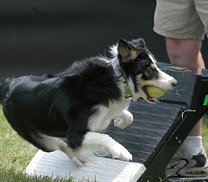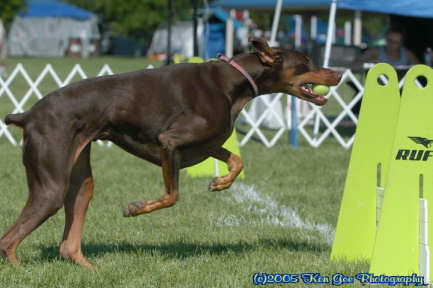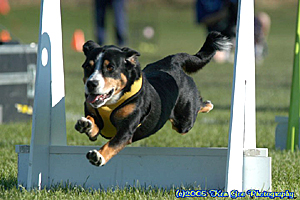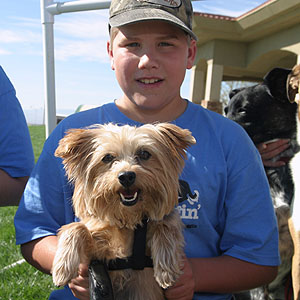|
Reprinted with permission
The below article is a letter written to
Region 5 in August of 2000 by the Regional Director, Alyson Brown. This
one letter to the region, along with implementing tougher standards in
regards to dogs crossing, has virtually eliminated the problem in Region
5. It may have been written five years ago but every word still stands
true today and everyone can benefit by her words of wisdom.
When I asked Alyson if we could print her
letter in the NAFA News she told me yes and added some more recent
thoughts which I have added following her original letter to the
Region.
Nancy Garcia, Region 5 RD
ARE
YOU READY TO RACE? By Alyson Brown
 That's a question I hope
all the teams members and team captains will ask as they prepare their
tournament entries. I've been concerned over the last few tournaments at
the increased occurrence of chasing, lane crossing, dog/dog contact and
other interference calls in our region's tournaments. I'm asking for
everyone's help to try to reduce that occurrence. That's a question I hope
all the teams members and team captains will ask as they prepare their
tournament entries. I've been concerned over the last few tournaments at
the increased occurrence of chasing, lane crossing, dog/dog contact and
other interference calls in our region's tournaments. I'm asking for
everyone's help to try to reduce that occurrence.
First, I want to emphasize that I am not directing the following comments
at any one club, team or individual. This is an "equal opportunity"
occurrence, and the judges and I have talked to a number of captains about
this problem.
Second, I'm not trying to be "holier than thou" on this subject. For those
who don't know, my dog was excused from his first tournament. He crossed
lanes and targeted another dog, sending jumps and dogs flying. It's not
something I'm proud of, but it happened and it taught me a lot. Luckily
the other dog wasn't seriously injured, but I learned a valuable lesson
from that tournament. (more about that later)
We have a lot of new clubs and new team members joining the sport of
flyball. That's a good thing, but it also brings challenges. One of those
challenges is to maintain the enthusiasm and attitude of your members, all
of whom want to race as soon as they can. I think we're seeing too many
green dogs being put into competition too soon. I hear people bragging
about how they just started flyball 60 days ago and their dog is already
racing in it's first tournament. Statements like that scare the %#$@ out
of me, both as RD and as someone racing in the other lane.
The ability to complete the pattern in a practice situation doesn't
necessarily translate into readiness to compete in a flyball tournament.
We all know the rare exceptions--the extremely talented dog/handler team
who beat the odds and are ready to race in an extraordinarily short amount
of time. But folks, that's the exception, not the rule. There are no quick
fixes in dog training. If a dog is not 100% at home, he's not going to
miraculously get better at a tournament. I hear people say "Well, he
chases at home, but that's with the dogs he knows and he won't do that at
a tournament." WRONG! He will probably do it more at a tournament.
 If you think your dog is 100%, think about these questions: Is he solid
with 2 lane work? Have we ever done 2 lane work? Have we ever done 2 lane
work with strange dogs? Have we ever done 2 lane work with strange dogs in
a strange location? If you think your dog is 100%, think about these questions: Is he solid
with 2 lane work? Have we ever done 2 lane work? Have we ever done 2 lane
work with strange dogs? Have we ever done 2 lane work with strange dogs in
a strange location?
If you answer no to any of these questions, I'd suggest there's a little
more preparation needed before a first tournament. I made some
recommendations to a couple of teams this weekend that I'd like to pass
along to the group.
-
Vary your practice locations. Many dogs
are perfectly comfortable in their own practice facility, but it blows
their minds to hit the road. Move to a different park, a new schoolyard,
another building.
-
Contact another team in your area and
set up a scrimmage practice. Your dog might not have any interest in the
dogs on its team, but everything changes when there are strange dogs in
the other lane.
-
Don't put too much pressure on a green
dog at its first tournament. Consider just warming a green dog up for a
couple of tournaments before putting it in the lineup. When you do add
it to the lineup, consider just running a few heats per day.
-
If the dog is stronger in one lane than
the other, consider just racing it in that lane for the first tournament
or two.
-
Do everything you can to set the dog up
to succeed, not fail. If the dog starts to interfere, either in warmup
or racing, pull it. You're not going to fix the problem at a tournament.
Go back home and re-tool.
 Bravo's problems at his first tournament were caused by my being too eager
to compete, not completing sufficient 2-lane work prior to the tournament,
and not pulling him immediately when I sensed he was getting distracted.
Following that first disastrous tournament, we went back home, worked a
lot harder on the distractions, set up as many situations as possible to
assess his tournament readiness, then raced him VERY SPARINGLY in his next
3 tournaments (probably no more than 3 races per tournament). Was it hard
to wait out with my dog when others I'd started flyball class with were
racing? You bet. But it was the only responsible thing to do. Bravo's problems at his first tournament were caused by my being too eager
to compete, not completing sufficient 2-lane work prior to the tournament,
and not pulling him immediately when I sensed he was getting distracted.
Following that first disastrous tournament, we went back home, worked a
lot harder on the distractions, set up as many situations as possible to
assess his tournament readiness, then raced him VERY SPARINGLY in his next
3 tournaments (probably no more than 3 races per tournament). Was it hard
to wait out with my dog when others I'd started flyball class with were
racing? You bet. But it was the only responsible thing to do.
Last piece of advice, don't get too comfortable once you get the chasing
problem licked. Some dogs never interfere again; others are always
"tempted." Be aware of what's going on around you. If a certain "type" of
dog sets your dog off, make sure you know what dogs are in the opposite
lane. If you have any doubts whether your dog will stay in its lane, err
on the side of caution. Bravo's 9 years old now, on the road to his FMX
and has run in every position on our team. However, there are still
situations that I know have the potential to go south, and I am never too
complacent. Watch your dog, and watch your surroundings.
I know there are some who think the judges and I are too harsh when we've
excused and/or written up a dog. I'd like you to think for a moment about
the impact of an interfering dog on the dog in the other lane. We have a
couple of dogs in the region who were on the receiving end of some pretty
intimidating interference at Astrohall. Those dogs are still having
confidence problems, attributable directly to the interference. You may
think your dog is "just playing," but the dog in the other lane doesn't
necessarily see it that way.
Our primary goal must be the safety of the dogs. Nothing can take priority
over that concern. If we don't all do our best to make sure our dogs are
really ready when we come to the line to race, we're jeopardizing the
safety of others.
Thanks for taking the time to read this lengthy message, and thanks in
advance for working toward safer racing in Region 5.
 I
guess the one thing I'd add today is that safety is everyone's
responsibility. It starts with the BOD, enacting rules and policies to
promote a safe racing environment. The RDs have the responsibility to
communicate with judges, tournament directors and club owners about the
importance of safety and proper training prior to competition. Judges
have the responsibility to promote safety in the ring. If there's a
problem, address it quickly and firmly, without regard to personalities or
emotional pleas for "just one more chance." Team Captains have the
difficult task of maintaining their members' enthusiasm for the sport
while ensuring all the proper training and proofing has occurred. They
have the hard decision to make of pulling a dog that's not ready, even if
it risks team strife. The individual handler is in the best position to
prevent accidents. Take a good hard realistic look and honestly answer
the question "Are you ready to race?" I
guess the one thing I'd add today is that safety is everyone's
responsibility. It starts with the BOD, enacting rules and policies to
promote a safe racing environment. The RDs have the responsibility to
communicate with judges, tournament directors and club owners about the
importance of safety and proper training prior to competition. Judges
have the responsibility to promote safety in the ring. If there's a
problem, address it quickly and firmly, without regard to personalities or
emotional pleas for "just one more chance." Team Captains have the
difficult task of maintaining their members' enthusiasm for the sport
while ensuring all the proper training and proofing has occurred. They
have the hard decision to make of pulling a dog that's not ready, even if
it risks team strife. The individual handler is in the best position to
prevent accidents. Take a good hard realistic look and honestly answer
the question "Are you ready to race?"
Alyson Brown
Photographs courtesy of
Region 19 clubs,
RUFFShot, &
Ken Gee
Photography. |











 That's a question I hope
all the teams members and team captains will ask as they prepare their
tournament entries. I've been concerned over the last few tournaments at
the increased occurrence of chasing, lane crossing, dog/dog contact and
other interference calls in our region's tournaments. I'm asking for
everyone's help to try to reduce that occurrence.
That's a question I hope
all the teams members and team captains will ask as they prepare their
tournament entries. I've been concerned over the last few tournaments at
the increased occurrence of chasing, lane crossing, dog/dog contact and
other interference calls in our region's tournaments. I'm asking for
everyone's help to try to reduce that occurrence.  If you think your dog is 100%, think about these questions: Is he solid
with 2 lane work? Have we ever done 2 lane work? Have we ever done 2 lane
work with strange dogs? Have we ever done 2 lane work with strange dogs in
a strange location?
If you think your dog is 100%, think about these questions: Is he solid
with 2 lane work? Have we ever done 2 lane work? Have we ever done 2 lane
work with strange dogs? Have we ever done 2 lane work with strange dogs in
a strange location?  Bravo's problems at his first tournament were caused by my being too eager
to compete, not completing sufficient 2-lane work prior to the tournament,
and not pulling him immediately when I sensed he was getting distracted.
Following that first disastrous tournament, we went back home, worked a
lot harder on the distractions, set up as many situations as possible to
assess his tournament readiness, then raced him VERY SPARINGLY in his next
3 tournaments (probably no more than 3 races per tournament). Was it hard
to wait out with my dog when others I'd started flyball class with were
racing? You bet. But it was the only responsible thing to do.
Bravo's problems at his first tournament were caused by my being too eager
to compete, not completing sufficient 2-lane work prior to the tournament,
and not pulling him immediately when I sensed he was getting distracted.
Following that first disastrous tournament, we went back home, worked a
lot harder on the distractions, set up as many situations as possible to
assess his tournament readiness, then raced him VERY SPARINGLY in his next
3 tournaments (probably no more than 3 races per tournament). Was it hard
to wait out with my dog when others I'd started flyball class with were
racing? You bet. But it was the only responsible thing to do.  I
guess the one thing I'd add today is that safety is everyone's
responsibility. It starts with the BOD, enacting rules and policies to
promote a safe racing environment. The RDs have the responsibility to
communicate with judges, tournament directors and club owners about the
importance of safety and proper training prior to competition. Judges
have the responsibility to promote safety in the ring. If there's a
problem, address it quickly and firmly, without regard to personalities or
emotional pleas for "just one more chance." Team Captains have the
difficult task of maintaining their members' enthusiasm for the sport
while ensuring all the proper training and proofing has occurred. They
have the hard decision to make of pulling a dog that's not ready, even if
it risks team strife. The individual handler is in the best position to
prevent accidents. Take a good hard realistic look and honestly answer
the question "Are you ready to race?"
I
guess the one thing I'd add today is that safety is everyone's
responsibility. It starts with the BOD, enacting rules and policies to
promote a safe racing environment. The RDs have the responsibility to
communicate with judges, tournament directors and club owners about the
importance of safety and proper training prior to competition. Judges
have the responsibility to promote safety in the ring. If there's a
problem, address it quickly and firmly, without regard to personalities or
emotional pleas for "just one more chance." Team Captains have the
difficult task of maintaining their members' enthusiasm for the sport
while ensuring all the proper training and proofing has occurred. They
have the hard decision to make of pulling a dog that's not ready, even if
it risks team strife. The individual handler is in the best position to
prevent accidents. Take a good hard realistic look and honestly answer
the question "Are you ready to race?"